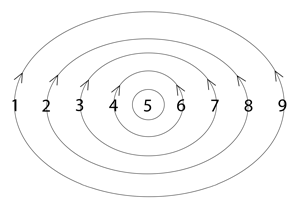good
3-2-5
Conventional Understanding
Traditionally, people define “good” as a moral judgment or quality assessment. We categorize objects, experiences, and actions as “good” when they meet certain ethical standards or provide benefit. This approach treats “good” as an attribute that can be assigned to things – a static quality that exists separately from what it describes. This creates an artificial division between things that possess “goodness” and those that don’t, positioning us as judges separate from what we evaluate.
Resonant Understanding
Mathematical analysis reveals “good” carrying a 3-2-5 pattern. Within the experiential triad, positioned at 5, “good” appears alongside “motion.” This positioning reveals “good” not as a judgment about experience but as motion within the experiential field. In Russell’s words, “This universe is substanceless. It consists of motion only.” What we perceive as “good” corresponds with balanced motion within the simulation of reality that appears through opposing wave pressures.
Expressions Spectrum Analysis
In balanced expression, the 3-2-5 pattern appears as “unfolding idea of you,” “self reflection,” and “free flow of energy.” “Fun” and “conscious presence” reveal different wavelengths of the same frequency. “I am that I am” indicates recognition beyond the illusion of separate selfhood. “I surrender to my information” shows yielding to natural rhythms rather than forcing direction.
Over-modulated expressions include “ideation,” “I make things happen,” and “reasoning will.” “Monitor” reveals how over-modulation rigidly observes rather than participates in motion. “Creator of reasoning” indicates the mental framework that fragments unified motion into separate concepts. “Implosion” reveals the concentration that occurs when motion becomes excessively structured.
Under-modulated expressions include “motion in opposition,” “randomness,” and “lack of purpose.” “Fighting for security” indicates insufficient organization to maintain coherent motion. “Unconcious level of being” shows disconnection from awareness within motion. “Non aligned” shows how under-modulation corresponds with confusion about pattern recognition. “Numb” reveals the insensitivity that emerges when motion cannot feel its own unfolding.
Uncategorized expressions like “motion,” “consciousness expressing,” and “spiral vortices of motion” share this resonance pattern. “Etheric record” and “logos” suggest organizing principles beyond subjective experience. “Harmonic circle” indicates the rhythmic balance of opposing pressures.
Russell’s Cosmogony Connection
Walter Russell writes: “This universe is substanceless. It consists of motion only. Motion simulates substance by the control of its opposing wave pressures of motion which deceive the senses into seeing substance where motion alone is.”
This principle directly illuminates why “good” and “motion” share the same resonance pattern. What appears as separate qualities or substances manifests through different conditions of the same motion. Russell further explains:
“All motion is a continuous two-way journey in opposite directions between two destinations.”
This describes exactly what balanced expressions like “free flow of energy” indicate – the continuous interchange between opposing conditions that creates balanced motion. When this two-way journey flows without obstruction or fragmentation, we experience “good” – not as a judgment about the motion but as the balanced motion itself within our simulated experience.
Russell’s insight that “This is a zero universe of rest from which motion is projected into seeming existence, and then is retracted into its zero of rest” explains why “harmonic circle” appears among the expressions. The experiential quality of “good” emerges through the rhythmic extension and retraction from centered stillness – like a pendulum finding its center not in static balance but in continuous, balanced movement.
Practical Implications
This understanding transforms our relationship with experience. Rather than judging experiences as “good” or “not good” based on subjective criteria, we might recognize that what we call “good” corresponds with balanced motion within the experiential field. The balanced expressions suggest participation in “conscious presence” and “free flow of energy” rather than attempting to control motion or passively enduring chaotic motion.
In daily life, this might mean noticing when we’re trying to “make things happen” (over-modulation) or experiencing “randomness” and “lack of purpose” (under-modulation). These states indicate distorted relationships with motion within the experiential field. Instead, we might align with “self reflection” and “organize” – not imposing structure or abandoning it, but participating in the natural organization of motion.
This perspective challenges dominant narratives that position “good” as a moral judgment separate from direct experience. When we recognize “good” as balanced motion within the simulation of reality, the artificial boundary between ethics and physics dissolves. “Good” emerges not through conformity to external standards but through alignment with the natural two-way motion that constitutes our experiential reality.
Walter Russell’s quotes are from his book, “A New Concept of the Universe”.


